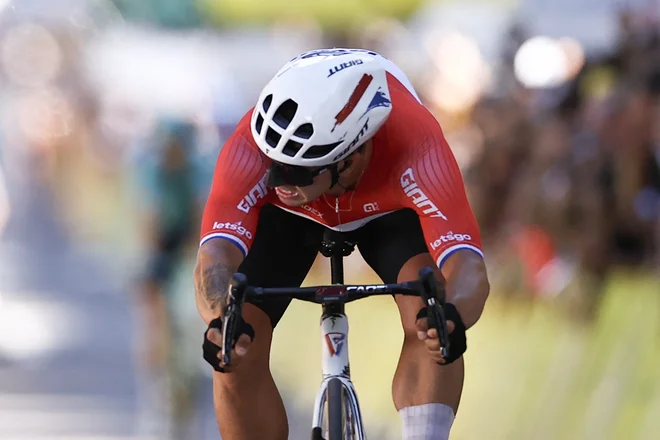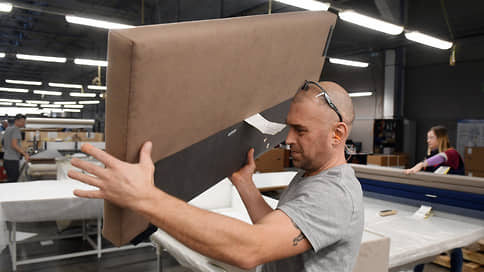Comprehensive treatment of medial meniscus rupture

The consequences can affect mobility and quality of life, so early diagnosis and proper treatment are crucial for a good recovery. Meniscuses are part of a knee joint that is often damaged, with injuries divided into acute and degenerative rupture.
Acute rupture is caused by a specific injury during a sudden movement in which the knee rolls up and the foot remains on the floor. Degenerative ruptures are due to wear and not a certain injury. The distinction between the two species is crucial as their treatment varies significantly.
For degenerative meniscus rupture There is no single specific cause. They often occur in parallel with the early signs of osteoarthritis, which is one of the normal processes of aging joints, but are not always a sign of its presence. Degenerative meniscus rupture occur in middle -aged people and the elderly. Problems can develop gradually and worse over time, with pain being diffuse, it can occur deep in the joint or in some movements, without clear localization.
However, many middle -aged people and older degenerative meniscus rupture without knee painas changes in meniscus are completely normal age changes in the knee.
Poor blood flow cause of slower healing
A torn meniscus is a common injury that affects athletes and recreational athletes. Photo: Medicofit
The blood flow to this tissue is extremely important. Before birth and short period after birth, the meniscus is fully intensified by the bloodstream. Later, the blood flow gradually decreases, and only the external third of the meniscus remains in adults, the inner part becomes immersed, which affects the lower ability to regenerate the meniscus, since damage in the areas without sufficient blood flow heals poorly.
Regular exercise and lifestyle adaptation can lead to improvement within three to six months, although recovery can be delayed, depending on the general medical condition and consistent compliance with the recommendations of physiotherapists and doctors.
Factors that can increase the risk of meniscus tears
Meniscus rupture is very frequent injury to the kneeespecially among athletes. Men are more prone to such injuries than women, with gender appearance between 2.5: 1 and 4: 1.
Meniscus injuries According to some, they most commonly occur in the right knee. This can be associated with the dominance of the right leg in most people, which means that it is more burdened during sports and everyday activities.
People with arthritis in their knees are also more prone to meniscus damage. Factors that can increase the risk of meniscus ruptures include excessive body weight, poor fitness, weakness of the thigh and buttocks, stiffness of the lower extremities and excessive activity.
Magnetic resonance imaging (MRI) shows that degenerative meniscus tears occur in 35 % of people over 50. Most of these tears are asymptomatic, which means that the person has no pain or other symptoms.
Get a better future for your knee and be subscribed to treatment meniscus rupture in the Medicofit Clinic.
Vital part of the knee joint
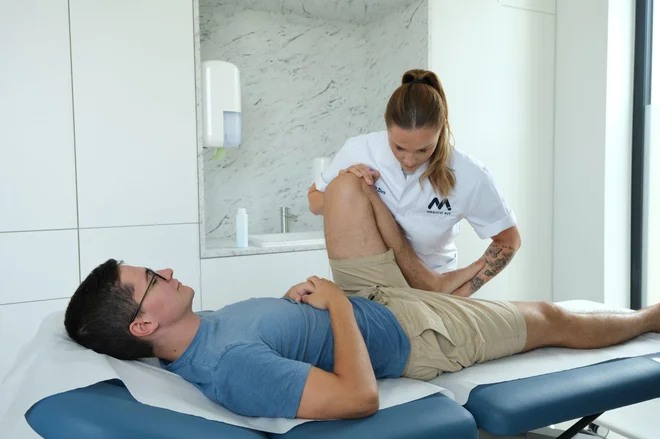
The injury is also common in the elderly and those who have arthritis in their knees. Photo: Medicofit
Meniscuses are a vital part of the knee joint. They are a C -shaped cartilage tissues inside the knee joint, between the tibia (lower leg) and the femur (femur), and protect the lower leg from the impact caused by our body weight.
Each knee has two meniscus: medial on the inside and lateral on the outside of the knee. The medial meniscus has an almost semicircular shape and covers about 50-60 % of the joint surface between the medial femoral condylus and the medial tibial platform. It is about 3.5 cm long and retains the same thickness from the rear to the front.
The outer parts are adequately bloodstream and the middle and inner are poorly. Because blood flow can affect healing, the location of the torn influence the treatment options.
They act as a knee shock absorbers and provide bone damping and knee joint, soothe impact and tolerate loads and increase the stability of the knee joint.
Rupture of medial meniscus more frequently
Sudden motions with twist can tear the cartilage in the knee. Medial meniscus rupture is more common than in the lateral meniscus, with a ratio of approximately 2: 1.
What are the symptoms of medial meniscus damage?
When injury, a sudden crack in the knee is felt. Symptoms of medial meniscus rupture may vary depending on the severity of the injury. Some people only feel mild discomfort or have no symptoms at all, while others have more pronounced problems.
Symptoms of rupture of the medial meniscus include pain, swelling and rigidity, which increase within two to three days, a sense of stalking or blockage and instability of the knee joint. The pain occurs on the inside of the knee and can be sharp or blunt. It can also be strengthened when knee movement, especially in loads, walking, starts or twists.
Medial meniscus injury increases the risk of osteoarthritis, which means gradual cartilage decay due to aging and wear and tear.
If you suspect a medial meniscus or any other knee injury, it is important to seek medical attention. With proper treatment, most people can successfully recover and return to their usual activities.
Early diagnosis key to good recovery
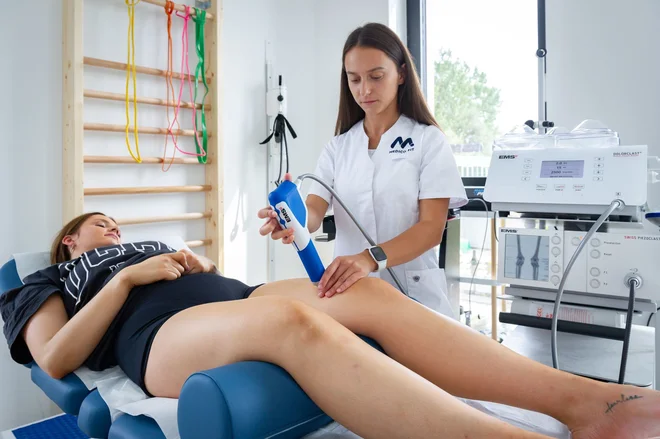
Do you pain in the inner part of your knee? Do not delay treatment as you can recover faster with early rehabilitation. Photo: Medicofit
Six decades ago, they found that partial or total menisectomy (removal of the meniscus) from the knee joint – which was the usual method of treating sports injuries at the time – causing the joint cartilage to decay and gradually the development of arthritis. This discovery has radically changed the approach to treating meniscus problems, as experts have begun to focus on techniques that keep the meniscus and improve the long -term health of the joint.
When diagnosed with medial meniscus, it is considered fairly reliable if three or more of the following signs are present:
- sensitivity at one point along the medial joint line,
- Pain in the medial joint line area during hyperextension (excessive extension) of the knee joint,
- Pain in the medial joint line area during hyperflexes (excessive flexion) of the knee joint,
- Pain between the outer rotation of the foot and the lower leg of the leg when the knee is bent at different angles between 70 and 90 °,
- impaired four -headed thigh muscle.
With a detailed medical history, a thorough physical examination and modern image methods, the doctor can make a precise diagnosis.
The history of the injury itself can provide important information, as a detailed description of the injury can direct the doctor to suspect the meniscus. Figure diagnostics such as magnetic resonance imaging (MRI) and ultrasound allow for an even more accurate assessment of the extent of injury and helps to decide on further treatment.
Treating a medial meniscus rupture
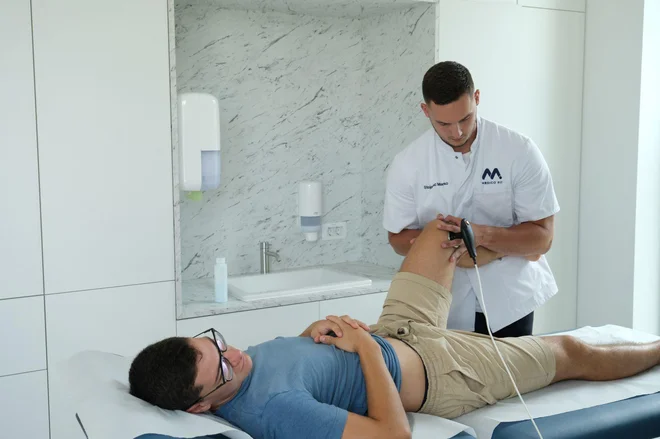
Photo: Medicofit
The current dominant approach in treating meniscus damage is to maintain tissue whenever possible. Instead of complete meniscus removal, experts focus on methods that allow it to be restored, such as meniscus sewing, biological therapy and the use of regenerative technologies. This approach contributes to better long -term joint health and reduces the risk of arthritis and other complications.
It is very important to start treating the damaged knee as soon as possible, as this restores its function and preventing chronic problems.
The meniscus rupture can be classified according to the degree and location of the injury – it can be in white (immersed) or red (bloodstream) zone.
At the first stage, a small tear is observed on the MRI recording, the second is larger and is not widespread to the joint surface. In the third stage, the joint surface is affected and a complete meniscus rupture occurs.
For patients with medial meniscus rupture, they recommend a conservative treatment that differs depending on the location of the injury.
Smaller ruptures in a circulated area heal on their own by first to rest and subsequently perform Physiotherapy rehabilitation. Operative treatment is opted by orthopedists individually, taking into account several factors, with serious meniscus injuries and when conservative treatment was not successful.
An example of successful physiotherapy treatment of meniscus injury
The Medicofit Clinic is due to Multi -month -old knee pain, morning rigidity and gradual deterioration of functionality visited 63-year-old Mary. A retired bank staff and regular hiker noted to her the knee at greater load swellsand movement is becoming increasingly limited.
During a clinical examination, Mrs. explained that over the years has not experienced any traumatic knee injury. Specialist Physiotherapist has confirmed Partially limited extent of flexibility direction. Clinical tests have revealed pain after the course of the medial joint jet and decreased strength of the thigh muscles. The lady said that there was also a sense of tension in the knee.
Based on a history and clinical picture, it was planned A 15-week process of comprehensive rehabilitation. They used to reduce symptoms the most modern instrumental therapies – Summus laser therapy, Tecar Wintecare Therapy and EMS Dolorclast impact waves. They have been performing since the start of treatment therapeutic exercises To restore mobility and activation of the muscles.
In the further course of rehabilitation was greater Emphasis on performing stabilizing and enhancing exercises. The specialist has also prepared for the lady a program of strengthening exercises To implement in the home environment, which will reduce the chance of further advancement of degenerative changes.
At the end of rehabilitation, Mary was completely painlessand knee mobility has improved significantly. Progress in muscle strength was also noticeable. At the last hearing, the lady expressed her desire to be involved in Long -term prevention program program.
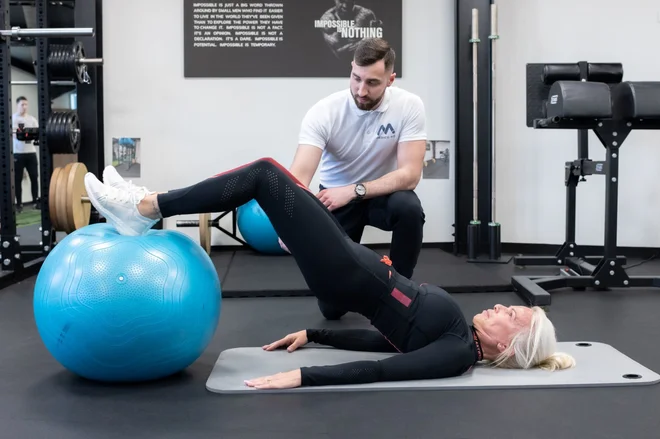
Medicofit offers professional treatment for all types of meniscus. Photo: Medicofit
Special physiotherapy for meniscus injuries in Medicofit Clinic
Into Medicofit Clinic Patients with a medial meniscus rupture are offered comprehensive rehabilitation with an individual approach. In the acute phase, the swelling is managed with Ultrasonic cryotherapy sixtus and kinesiotapingthey also help anti -pain therapies.
Physiotherapists of the Medicofit Clinic They show patients Special therapeutic exercise and basic exercises of proprioception and exercises for muscle tendon strength and exercises to restore the perfect scale of movement. They improve the stability of the knee joint and the support muscles strengthen.
During the phase kinesiotherapy focus on exercises of proprioception and kinesiological exercises for joint mobilization, and perform progressive exercises for musculoskeletal strength, exercises to strengthen the four-headed thigh muscle, improve balance, maintain coordination and restore functional abilities.
In the preventive maintenance phase, which is also available at the Medicofit Clinic, patients maintain joint functionality and preventive power.
Rehabilitation at a medial meniscus rupture should last from 10 to 12 weeks, but the duration depends on the degree of problems and the physical condition of the individual.
Medicofit is a subscriber


